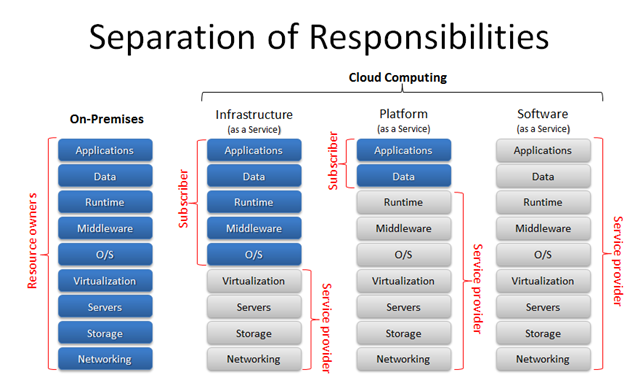Cloud Computing Primer for IT Pros
One way to describe cloud computing is to base on the service delivery models. There are three, namely Software-as-a-Service (SaaS), Platform-as-a-Service (PaaS) and Infrastructure-as-a-Service (IaaS) and depending on which model, a subscriber and a service provider hold various roles and responsibilities in completing a service delivery. Details of SaaS, PaaS, and IaaS are readily available and are not repeated here. Instead, a schematic is shown below highlighting the various functional components exposed in the three service delivery models in cloud computing compared with those managed in an on-premises deployment.
Essentially, cloud computing presents a separation of a subscriber’s roles and responsibilities from those of a service provider’s. And by subscribing a particular service delivery model, a subscriber implicitly agrees to relinquish certain level of access to and control over resources. In SaaS, the entire deliveries are provided by a service provider through cloud. The benefit to a subscriber is there is ultimately no maintenance needed, other than the credentials to access the application, i.e. the software. At the same time, SaaS also means there is little control a subscriber has on how the computing environment is configured and administered outside of a subscribed application. This is the user experience of, for example, some email offering or weather reports in Internet.
In PaaS, the offering is basically the middleware where the APIs exposed, the service logic derived, the data manipulated, and the transactions formed. It is where most of the magic happens. A subscriber in this model can develop and deploy applications with much control over the applied intellectual properties.
Out of the three models, IaaS provides most manageability to a subscriber. Form OS, runtime environment, to data and applications all are managed and configurable. This model presents opportunities for customizing operating procedures with the ability to on-demand provision IT infrastructure delivered by virtual machines in cloud.
An important take-away is that we must recognize and be pre-occupied with the limitations of each service delivery model when assessing Cloud Computing. When a particular function or capability like security, traceability, or accountability is needed, yet not provided with a subscribed service, a subscriber needs to negotiate with the service provider and put specifics in a service level agreement. Lack of understanding of the separation of responsibilities in my view frequently results in false expectations of what cloud computing can or cannot deliver.
